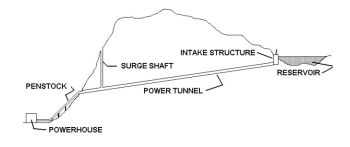Tunnels: Difference between revisions
From ASDSO Dam Safety Toolbox
No edit summary |
No edit summary |
||
| Line 2: | Line 2: | ||
__NOTOC__ | __NOTOC__ | ||
---- | ---- | ||
{{Picture | |||
<!-- Add image file name (ex.image.jpg) --> | |||
|image=tunnel1.jpg | |||
<!--Add link if applicable --> | |||
|link= | |||
<!-- Add picture caption --> | |||
|caption=Typical tunnel diagram (FERC) | |||
}} | |||
<!-- Introductory paragraph or topic page summary --> | <!-- Introductory paragraph or topic page summary --> | ||
Revision as of 06:15, 16 September 2022

|
| Typical tunnel diagram (FERC) |
Tunnels are long underground excavations with two or more openings to the surface, usually having a uniform cross section used for access, conveying flows, etc. Tunnels are most often used in mountainous areas. Tunnels can be divided into two basic types, lined and unlined.
Best Practices Resources
Citations:
Revision ID: 3405
Revision Date: 09/16/2022
